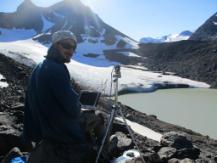Adrian Dye
Associate Lecturer
Profile
Biography
Adrian is a lecturer and researcher who is particularly interested in glacial and periglacial environments, remote sensing and GIS. He is a keen Environmentalist and promotes sustainability where ever possible! His undergraduate dissertation utilised pixel analysis from digital camera transect surveys to map the distribution of Cryoconite across glaciers in Svalbard, which gave him a taste for research. Adrian graduated with a Geography BSc in 2007 and completed a Secondary Geography Teacher PGCE in 2009, attaining Qualified Teacher Status in 2010. Adrian has a strong interest in education and particularly developing strategies to support successful independent learning. Adrian taught for five years in secondary schools (up to A level), but was drawn back into research and investigated the degradation of ice cored moraine in Arctic Sweden for his MSc dissertation in 2015.
Adrian became an Associate Lecturer in January 2020 and completed his PhD in June 2020, which focused on how lakes evolve in front of glacier termini as they retreat, with a particular emphasis on the thermal processes acting within the system.
Research
Overview
PhD Thesis: Investigating the Thermal Regime of Proglacial Lakes and Influence on Mass Loss of Glaciers in Arctic Sweden
With: Dr. David Rippin, Dr. Rob Bryant (University of Sheffield)
Funding: Natural Environment Research Council (NERC ACCE DTP)
The first stage of the PhD project used satellite multi-spectral (optical and near infrared) imagery to examine how proglacial lakes have developed (or disappeared) in front of glaciers that leave basins as they retreat across a region of Arctic Sweden and Norway. This provides an inventory of proglacial lakes to assess how numerous they are and also a baseline data set to assess how changes in proglacial lakes have affected the retreat rates of proximal glaciers in the study area. Some authors have reported areas where glaciers that terminate in lakes are retreating as fast as glaciers terminating in the ocean. Whilst numerous studies have investigated the mechanical processes of proglacial lakes influencing glacier mass loss, the thermal processes of proglacial lakes influencing glacier melt rates has received relatively little attention. In the second stage of the PhD Adrian conducted a series of temperature surveys and observed rapid thermal erosion of an actively calving glacier (affectionately known as Kas’ glaciar) in Sweden during 2017, the first to be reported from an Arctic lake terminating glacier. This was also the first study to utilise thermal infrared imagery and Adrian is currently developing a methodology for mapping proglacial lake temperatures using a UAV.
The work at Kas’ glaciar continued into a second field season in 2019 for the ‘Cold Ice in a Warm Bath’ project (funded by INTERACT), which produced a temperature record directly from the ice front (despite calving events) sonar imagery of the subaqueous ice front and regular time lapse imagery of the subaerial ice front, in collaboration with Joe Mallalieu and Fran Falcini. The same collaboration will be undertaking a third field season in 2021 on Kas’ glaciar as part of their Glacier Response to Extreme Temperature Anomalies (GRETA) project (INTERACT funding), to compare the mass loss at Kas’ glaciar to other land terminating glaciers in Arctic Sweden. Adrian also continues to work on utilising satellite thermal imagery to obtain surface temperatures of glacial lakes and is involved in the European Space Agency Climate Change Initiative.

